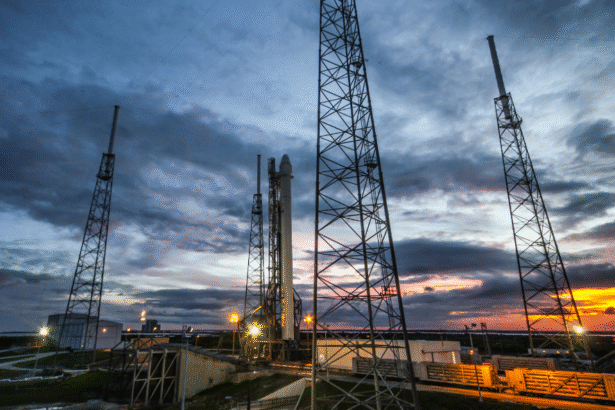Space isn’t just about exploring distant planets—it’s also about protecting ourselves. Agencies like NASA, the European Space Agency (ESA), and others are playing a critical role in environmental conservation using cutting-edge satellite Earth observation tools. From tracking wildfires and rising sea levels to monitoring air quality and deforestation, these agencies are tackling some of the world’s most pressing environmental threats—from space.
In this blog, we’ll explore how space agencies use advanced technology to keep a close eye on our planet and help us respond to climate and ecological crises more effectively.
The Power of Satellite Earth Observation

Earth observation satellites provide real-time, consistent, and global insights that are simply not possible from the ground. By orbiting the Earth, these satellites collect valuable data on land use, vegetation, oceans, ice sheets, and the atmosphere.
NASA’s Role in Global Environmental Monitoring
NASA’s Earth Science Division has developed an impressive suite of satellite missions to support climate change detection, air and water monitoring, and disaster preparedness. Some key tools include:
- MODIS (Moderate Resolution Imaging Spectroradiometer): Tracks wildfires, clouds, and land surface changes.
- Landsat Program: A joint effort with the USGS that has monitored Earth’s surface since 1972.
- OCO-2 (Orbiting Carbon Observatory): Measures global carbon dioxide levels.
- GRACE-FO: Tracks changes in groundwater and ice mass.
These missions provide data for scientists, environmentalists, and governments to assess and respond to ongoing changes.
ESA and International Collaboration

NASA is not working alone. The European Space Agency (ESA) operates its Copernicus program, which includes a fleet of Sentinel satellites. These instruments provide detailed environmental insights across Europe and globally.
Together, agencies like NASA, ESA, ISRO (India), JAXA (Japan), and CSA (Canada) collaborate on missions and share data, creating a more complete and reliable global picture. This branded collaboration model improves access to information, regardless of borders.
Tackling Climate Change from Orbit

Climate change poses a serious threat to ecosystems, human health, agriculture, and infrastructure. Space agencies are working hard to track and understand these changes using satellite data.
Key Satellite Contributions:
- Melting Ice and Glaciers: Satellites like ICESat-2 help track the loss of polar ice.
- Rising Sea Levels: NASA and NOAA’s Jason series track global sea surface height.
- Carbon Monitoring: Satellites detect CO₂ emissions from both natural and industrial sources.
- Temperature Trends: Satellites monitor long-term global warming and regional anomalies.
This information is critical for creating accurate climate models, setting emission targets, and guiding policy.
Monitoring Natural Disasters in Real Time
Space agencies are essential during natural disasters. Satellite images and radar systems can detect the scope of a disaster and provide updates faster than many ground-based systems.
How NASA Supports Disaster Response:
- Provides real-time images of hurricanes, floods, and earthquakes
- Maps disaster zones and damage using radar (e.g., Sentinel-1, ALOS)
- Assists governments and relief agencies through the NASA Disasters Program
For example, during major events like Hurricane Katrina or the 2023 Turkey-Syria earthquake, satellite data was used to support search and rescue efforts, infrastructure repair, and humanitarian aid planning.
Pollution Detection and Air Quality Monitoring
Air and water pollution have serious public health impacts. NASA and ESA monitor pollutants that affect both local air quality and the planet's climate balance.
Monitoring Tools:
- OMPS (Ozone Mapping and Profiler Suite): Measures the ozone layer and harmful UV radiation.
- TEMPO: An upcoming NASA mission that will deliver hourly air quality updates across North America.
- Sentinel-5P: Monitors air pollutants like nitrogen dioxide, carbon monoxide, and methane.
Space-based pollution tracking helps cities make smarter decisions and informs public health campaigns.
Forests, Biodiversity, and Habitat Loss
Forests are critical for storing carbon and protecting biodiversity. Yet illegal logging and land conversion continue to threaten ecosystems worldwide.
How Satellites Help:
- NASA and ESA satellites provide imagery that can detect deforestation within days.
- Platforms like Global Forest Watch use satellite data to alert governments and conservation groups.
- Biodiversity hotspots can be monitored for habitat loss, invasive species, and ecosystem health.
These tools are essential for tracking progress toward international goals like the UN's Sustainable Development Goals (SDGs) and Paris Agreement.
Making Data Accessible: Tools for the Public
Many of the tools developed by NASA are freely accessible, supporting open science and encouraging collaboration. Whether you’re a student, scientist, educator, or policymaker, these platforms offer easy ways to explore environmental data:
- NASA EarthData: A hub for downloading raw satellite datasets.
- NASA Earth Observatory: Offers curated articles and visualizations.
- Worldview: An interactive map to visualize near-real-time satellite data.
- NASA's Mobile App: Track Earth and space missions from your phone.
These platforms support informational search intent and allow users to explore environmental challenges through an engaging and data-driven lens.
Why Space-Based Environmental Monitoring Matters
Here’s why space technology is uniquely suited for tracking environmental threats:
- Global Coverage: No corner of the Earth is too remote or politically inaccessible.
- Consistency: Long-term monitoring allows for accurate trend detection.
- Speed: Some satellites can provide updates in near-real time.
- Transparency: Public access to data encourages accountability and action.
From geo-targeted insights in the US, Europe, and Asia to transactional tools for downloading datasets, space monitoring promotes smarter, faster environmental decision-making.
The Future of Environmental Conservation from Space
The future holds even more promise. New satellite constellations, AI-powered analysis, and hyperspectral imaging will allow even finer detail in climate observation. Projects like NASA’s NISAR (launching 2025) will track land and ice surface movement with unprecedented accuracy.
Moreover, commercial satellite operators are now entering the environmental monitoring space. This creates opportunities for new partnerships and faster innovation, ensuring that Earth remains a priority in the growing space industry.
Conclusion:
As environmental threats grow in scale and complexity, space agencies are becoming our planetary guardians. Agencies like NASA and ESA are not only tracking the damage—we now have the data, tools, and technology to prevent and mitigate it.
Through international collaboration, open data platforms, and powerful Earth observation tools, these agencies are helping ensure a sustainable future for all. The more we understand our planet from above, the better we can protect it here on the ground.








